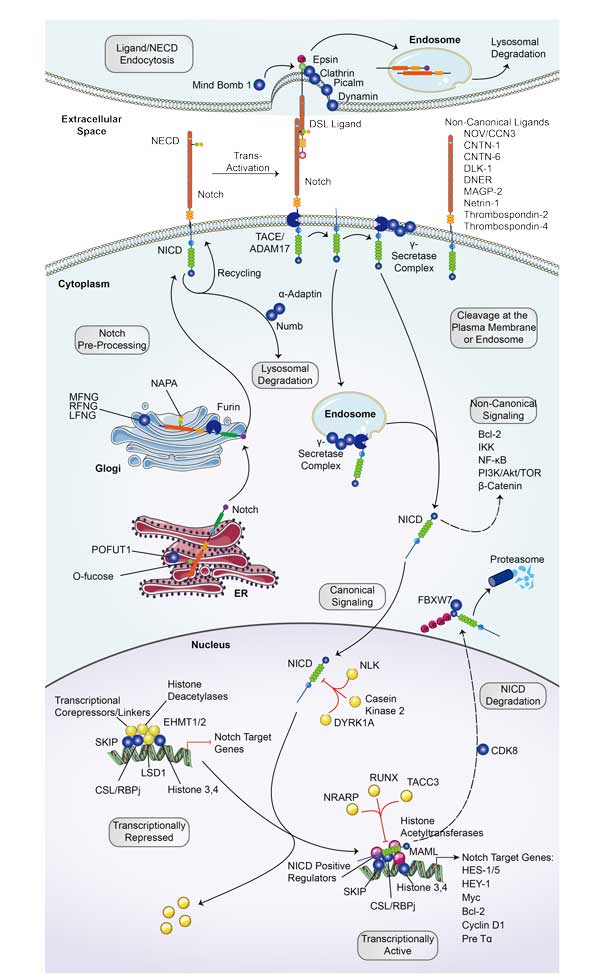SIRT1
-
Official Full Name
sirtuin 1
-
Overview
This gene encodes a member of the sirtuin family of proteins, homologs to the yeast Sir2 protein. Members of the sirtuin family are characterized by a sirtuin core domain and grouped into four classes. The functions of human sirtuins have not yet been determined; however, yeast sirtuin proteins are known to regulate epigenetic gene silencing and suppress recombination of rDNA. Studies suggest that the human sirtuins may function as intracellular regulatory proteins with mono-ADP-ribosyltransferase activity. The protein encoded by this gene is included in class I of the sirtuin family. Alternative splicing results in multiple transcript variants. [provided by RefSeq, Dec 2008] -
Synonyms
SIRT1; sirtuin 1; SIR2L1; NAD-dependent protein deacetylase sirtuin-1; hSIR2; hSIRT1; SIR2alpha; sir2-like 1; sirtuin type 1; SIR2-like protein 1; regulatory protein SIR2 homolog 1; NAD-dependent deacetylase sirtuin-1;
- Recombinant Proteins
- Cell & Tissue Lysates
- Protein Pre-coupled Magnetic Beads
- Assay Kits
- Chicken
- Human
- Mouse
- Rat
- E. coli
- E.coli
- HEK293
- HEK293T
- Mammalian Cell
- Mammalian cells
- Sf9 Insect Cell
- C
- His
- Flag
- GST
- His (Fc)
- Avi
- Myc
- DDK
- Myc|DDK
- N/A
- N
- Background
- Quality Guarantee
- Case Study
- Involved Pathway
- Protein Function
- Interacting Protein
- SIRT1 Related Articles
- SIRT1 Related Research Area
- SIRT1 Related Signal Pathway
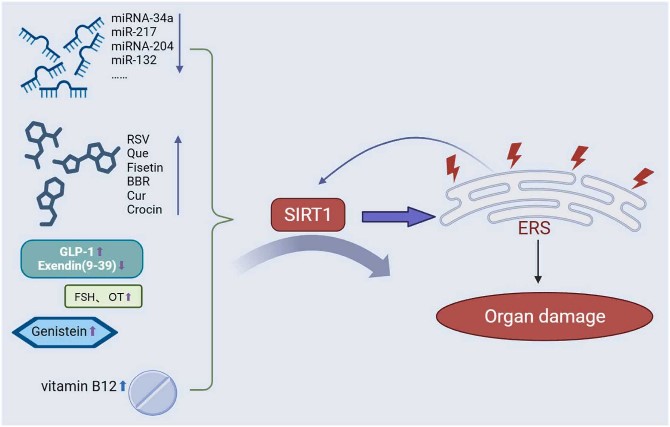
Fig1. Schematic diagram of the regulation of SIRT1 expression and apoptosis. (He Hu, 2024)
What is SIRT1 protein?
SIRT1 (sirtuin 1) gene is a protein coding gene which situated on the long arm of chromosome 10 at locus 10q21. This gene encodes a member of the sirtuin family of proteins, homologs to the yeast Sir2 protein. Members of the sirtuin family are characterized by a sirtuin core domain and grouped into four classes. The protein encoded by this gene is included in class I of the sirtuin family. The SIRT1 protein is consisted of 747 amino acids and its molecular mass is approximately 81.7 kDa.
What is the function of SIRT1 protein?
Sirtuin 1 (SIRT1) is an NAD + dependent deacetylase. SIRT1 regulates a variety of metabolic pathways, such as glucose metabolism, lipid metabolism and insulin signaling pathway through deacetylation. By binding to DNA to acetylate, it affects chromatin structure and gene expression, maintains genomic stability and integrity, and regulates cell life. It can also regulate the expression of a variety of antioxidant proteins to help cells resist oxidative damage and reduce the degree of oxidative stress in cells.
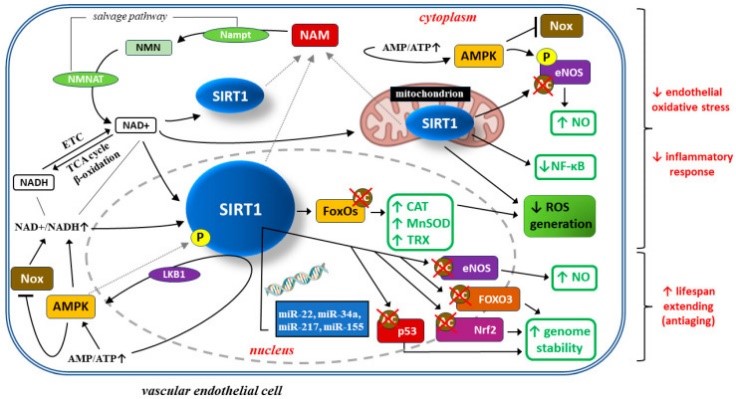
Fig2. Beneficial effects of SIRT1 on vascular endothelial cells in pre-eclampsia: limiting oxidative stress, inflammatory response, and cellular ageing. (Mateusz Wątroba, 2023)
SIRT1 Related Signaling Pathway
SIRT1 can deacetylate a variety of substrates to regulate intracellular signaling pathways and gene expression. SIRT1 is involved in the inflammatory response by deacetylating the p65 subunit of NF-κB and inhibiting the activity of the NF-κB signaling pathway. SIRT1 can activate AMPK (AMP-activated protein kinase) signaling pathway, promote energy metabolism regulation and maintain intracellular energy balance by regulating cell metabolic balance. SIRT1 can also deacetylate β-catenin, inhibit its activity in the Wnt signaling pathway, and affect processes such as cell proliferation and stem cell regulation.
SIRT1 Related Diseases
SIRT1 plays an important role in the regulation of apoptosis, cell proliferation and DNA damage repair. In individual tumor cells, inhibition of SIRT1 activity may inhibit tumor development through multiple mechanisms. SIRT1 plays an important role in glycolipid metabolism, and its abnormal activity is closely related to the occurrence and development of metabolic diseases such as obesity and diabetes. It is also associated with neurodegenerative diseases, cardiovascular diseases and inflammatory diseases.
Bioapplications of SIRT1
In addition to being a target for disease research, SIRT1 can also be used to develop activators for ameliorating aging-related diseases. The most important is to study the function and regulatory mechanism of SIRT1, which is conducive to the development of new drugs targeting SIRT1 for the treatment of related diseases.
High Purity
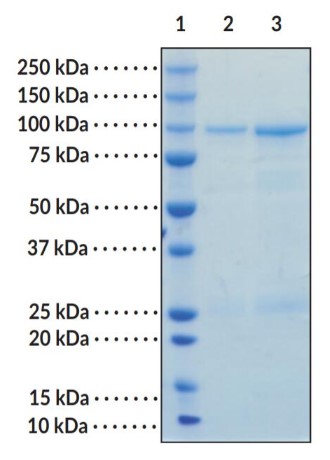
Fig1. SDS-PAGE (SIRT1-30H) (PROTOCOL for western blot)
.
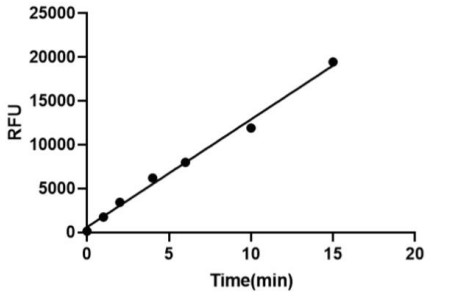
Fig2. Activity Data. (SIRT1-30H)
Case study 1: Lili Lian, 2023
To determine whether SIRT1 regulates high glucose (HG)-induced inflammation and cataract formation through modulating TXNIP/NLRP3 inflammasome activation in human lens epithelial cells (HLECs) and rat lenses. HG stress from 25 to 150 mM was imposed on HLECs, with treatments using small interfering RNAs (siRNAs) targeting NLRP3, TXNIP, and SIRT1, as well as a lentiviral vector (LV) for SIRT1. Rat lenses were cultivated with HG media, with or without the addition of NLRP3 inhibitor MCC950 or SIRT1 agonist SRT1720. Western blots, and immunofluorescent staining evaluated the mRNA and protein levels of SIRT1, TXNIP, NLRP3, ASC, and IL-1β.
HG stress induced a decline in SIRT1 expression. Transfections of si-SIRT1 and LV-SIRT1 exerted inverse effects on NLRP3 inflammasome activation, suggesting that SIRT1 acts as an upstream regulator of TXNIP/NLRP3 activity. The TXNIP/NLRP3 inflammasome pathway promotes HG-induced inflammation and HLEC pyroptosis, which is negatively regulated by SIRT1.
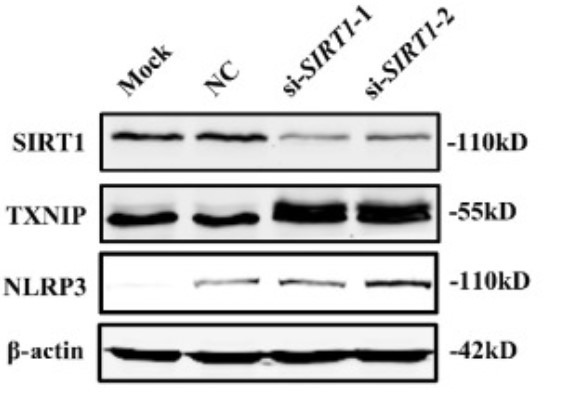
Fig1. HLECs were transfected with control or NLRP3 siRNAs for 72 hours. Cells were lysed and immunoblotted with antibodies against SIRT1, TXNIP, NLRP3, and β-actin.
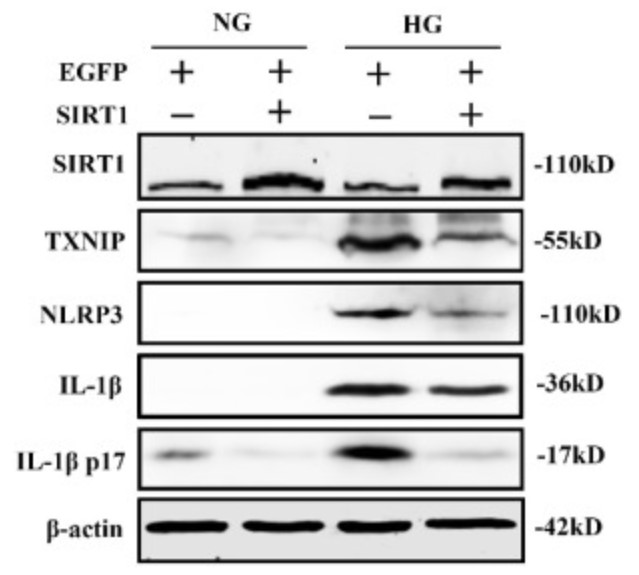
Case study 2: Lars Erichsen, 2022
The aging process is manifested by a multitude of inter-linked biological processes. These processes contribute to genomic instability, telomere attrition, epigenetic alterations, loss of proteostasis, de-regulated nutrient-sensing, mitochondrial dysfunction, cellular senescence, stem cell exhaustion, and altered intercellular communication. The mammalian ortholog of the yeast silent information regulator (Sir2) SIRT1 is a NAD+-dependent class III histone deacetylase and has been recognized to be involved in many of the forementioned processes.
SIX2-positive urine derived renal progenitor cells-UdRPCs isolated directly from human urine show typical hallmarks of aging. This includes the subsequent transcriptional downregulation of SIRT1 and its downstream targets AKT and GSK3β with increased donor age. The researchers provide evidence that the renal progenitor transcription factor SIX2 binds to the coding sequence of SIRT1. Furthermore, they show that the SIRT1 promoter region is methylation sensitive and becomes methylated during aging, dividing them into SIRT1-high and -low expressing UdRPCs.
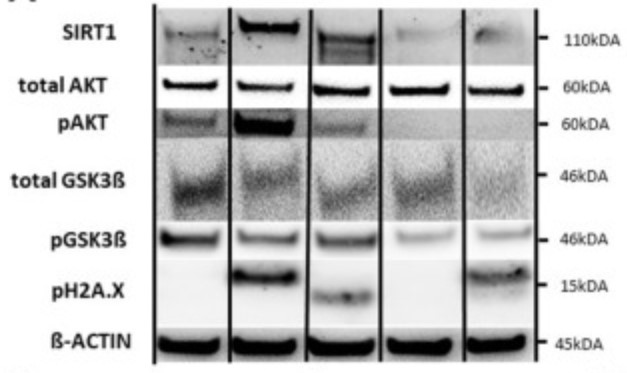
Fig3. Relative protein expression normalized to β-ACTIN for SIRT1, AKT and GSK3β and relative protein phosphorylation for AKT, GSK3β and pH2A.X was detected by Western blot.
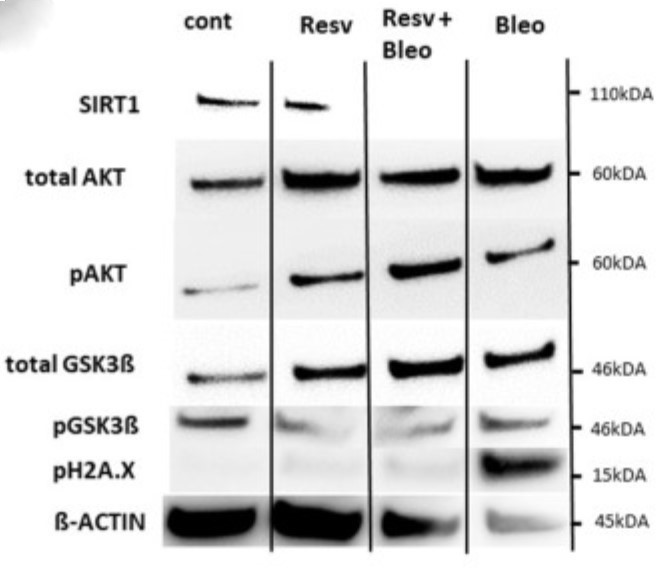
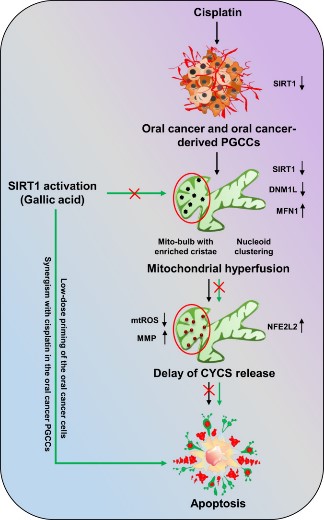
Fig1. Non-apoptotic doses of CDDP downregulate the expression of SIRT1 in oral cancer and CDDP-resistance oral cancer-derived PGCCs. (Srimanta Patra, 2023)
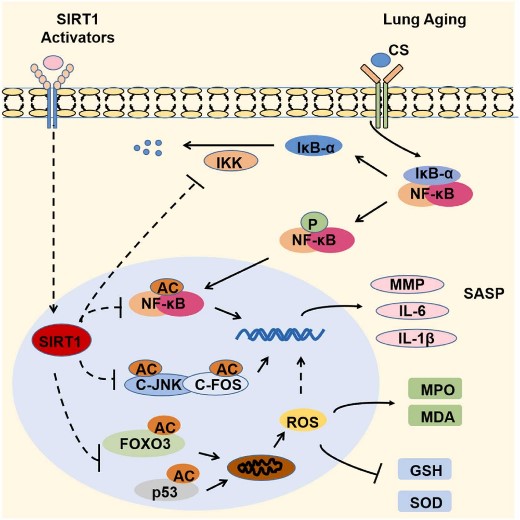
Fig2. SIRT1 inhibits the cell senescence-associated secretory phenotype (SASP; secretion of IL-6, IL-1β, and MMPs) by regulating the SIRT1/NF-κB and SIRT1/JNK pathways, thereby alleviating the inflammatory response. (Chaoqun Sun, 2023)
SIRT1 involved in several pathways and played different roles in them. We selected most pathways SIRT1 participated on our site, such as FoxO signaling pathway, AMPK signaling pathway, MicroRNAs in cancer, which may be useful for your reference. Also, other proteins which involved in the same pathway with SIRT1 were listed below. Creative BioMart supplied nearly all the proteins listed, you can search them on our site.
| Pathway Name | Pathway Related Protein |
|---|---|
| FoxO signaling pathway | MAPK11;SGK1;CCNB3;RAF1A;FASLG;KLF2A;MAPK13;MAPK1;MAPK8 |
| AMPK signaling pathway | PPP2R5C;PPP2CB;INSR;INS;Scd2;PIK3CB;AKT1S1;G6PC3;LEPR |
| MicroRNAs in cancer | PDGFRB;SOX4;BRCA1;MET;PDGFB;DNMT1;EFNA3;HDAC1;CD44 |
SIRT1 has several biochemical functions, for example, HLH domain binding, NOT NAD+ ADP-ribosyltransferase activity, NAD+ binding. Some of the functions are cooperated with other proteins, some of the functions could acted by SIRT1 itself. We selected most functions SIRT1 had, and list some proteins which have the same functions with SIRT1. You can find most of the proteins on our site.
| Function | Related Protein |
|---|---|
| HLH domain binding | PKD2;UBE2I;SIRT1 |
| NOT NAD+ ADP-ribosyltransferase activity | SIRT5;SIRT2;SIRT1;SIRT3 |
| NAD+ binding | SIRT2;SIRT6;SIRT1;HADH;UXS1;GLUD1;SIRT5;ALDH1A3;SIRT7 |
| NAD-dependent histone deacetylase activity | SIRT6;SIRT1;SIRT2 |
| NAD-dependent histone deacetylase activity (H3-K9 specific) | SIRT1;SIRT6 |
| NAD-dependent protein deacetylase activity | SIRT2;SIRT1 |
| bHLH transcription factor binding | USF2;EP300;SP1;HAND1;BHLHE40;TCF21;IKZF4;SIRT1;ISL1 |
| core promoter sequence-specific DNA binding | NR4A3;NRIP1;ZNF750;NFYA;RORA;TP53;TRP53;PDX1;TOP1 |
| deacetylase activity | C6orf130;HDAC2;NDST4;SIRT1;NDST1;MAPK1IP1L;MACROD2;HDAC1;AADAC |
| enzyme binding | LDB1;C6orf211;SCNM1-PS;SCARB2;ATF7;USP22;AXIN1;NOS1;LYN |
| histone binding | BRD7;HIST1H47;PYGO2;NPM1;UHRF1;HIST2H4A;DAXX;NCL;HIST1H4K |
| histone deacetylase activity | HDAC10;SIRT1;HDAC3;HDAC11;SIRT2;HDAC8;NACC2;HDAC6;HDAC9B |
| identical protein binding | TRIM23;EED;GOT1;CLDN8;VWA1;UHRF1;TRIP13;C1QL2;GRB2 |
| keratin filament binding | SIRT1;VIM;KRT14 |
| metal ion binding | ZNHIT3;SIRT1;POGZA;ZSCAN4C;LIMS2;TRIM50;ATP1A1A.1;MGAT5B;ZNF688 |
| mitogen-activated protein kinase binding | TPR;TNIP1;MAPKAPK2B;MICALCL;CDK5RAP3;PLCB4;GTF2I;MAPKAPK5;SIRT1 |
| nuclear hormone receptor binding | NCOA3;SNW1;TACC2;CTNNB1;SMARCD3;CRY1;Ankar;MED1;NRIP1 |
| p53 binding | MSX1;DAXX;MAPKAPK5;AXIN1;AAAS;TRIM29;PSME3;ZNF385C;RCHY1 |
| protein C-terminus binding | DLG4;EFHC1;HIC2;DLG1;CDK7;PCGF1;MID1IP1;ECM1;PEX12 |
| protein binding | CABP5;BORA;HMGB1;NBN;MED16;SMO;NMNAT1;TRAIP;MAP3K2 |
| protein deacetylase activity | HDAC1;HDAC9;HDAC3;HDAC5;SIRT2;SIN3A;HDAC10;HDAC2;SIRT1 |
| transcription corepressor activity | ATF3;YY1;PBXIP1;UBP1;ZHX3;CCAR1;ZNF136;WNT4;TAF9B |
| transcription factor binding | PAXBP1;CSNK2B;HOXA7;JUNBB;RELA;DIP2A;IRF4;NKX3;PURB |
SIRT1 has direct interactions with proteins and molecules. Those interactions were detected by several methods such as yeast two hybrid, co-IP, pull-down and so on. We selected proteins and molecules interacted with SIRT1 here. Most of them are supplied by our site. Hope this information will be useful for your research of SIRT1.
TP53; WRN
- Q&As
- Reviews
Q&As (6)
Ask a questionStudies have found that SIRT1 plays an important role in tissue regeneration. Activation of SIRT1 can promote the proliferation and differentiation of stem cells, which contributes to tissue regeneration and repair.
Activation of SIRT1 promotes autophagy, which helps to remove damaged organelles and proteins and maintain cell health.
SIRT1 regulates mitochondrial function. Activation of SIRT1 can improve mitochondrial metabolism and function, contributing to energy metabolism and cell survival.
Studies have found that SIRT1 exerts carcinogenic effects in some cancers, but exerts anti-cancer effects in others. It depends on the type of cancer and environmental factors.
SIRT1 has potential therapeutic value in drug development. The development of small molecule drugs targeting SIRT1 can be used to treat a variety of diseases, including aging, diabetes, cardiovascular diseases, and neurodegenerative diseases.
SIRT1 interacts and regulates with other sirtuins. For example, SIRT1 can regulate the expression and activity of other Sirtuins, and other Sirtuins can also regulate the activity of SIRT1.
Customer Reviews (3)
Write a reviewResulting banding is clear and bright, much more than expected.
SIRT1 has high safety, environmental protection and no pollution.
The quality is so good. It saves a lot of time. Good.
Ask a Question for All SIRT1 Products
Required fields are marked with *
My Review for All SIRT1 Products
Required fields are marked with *


